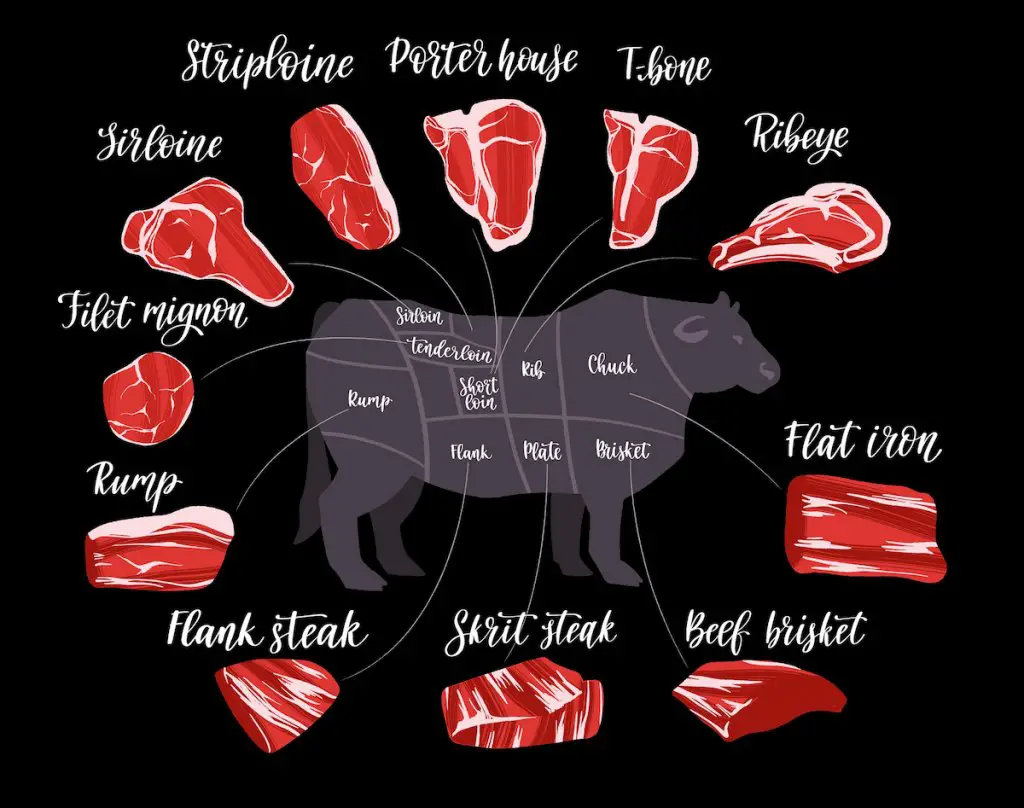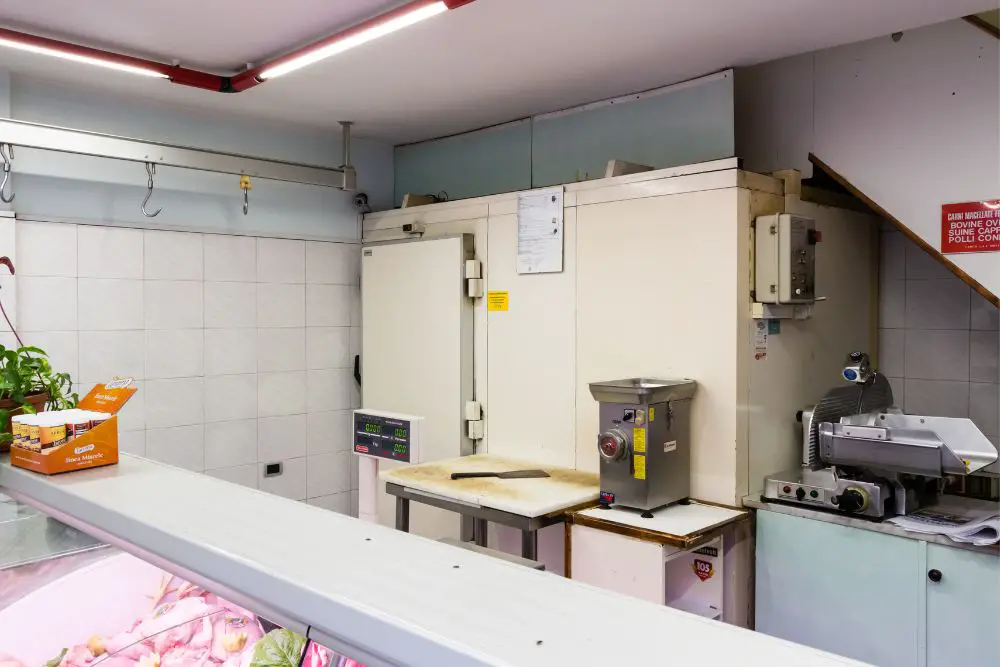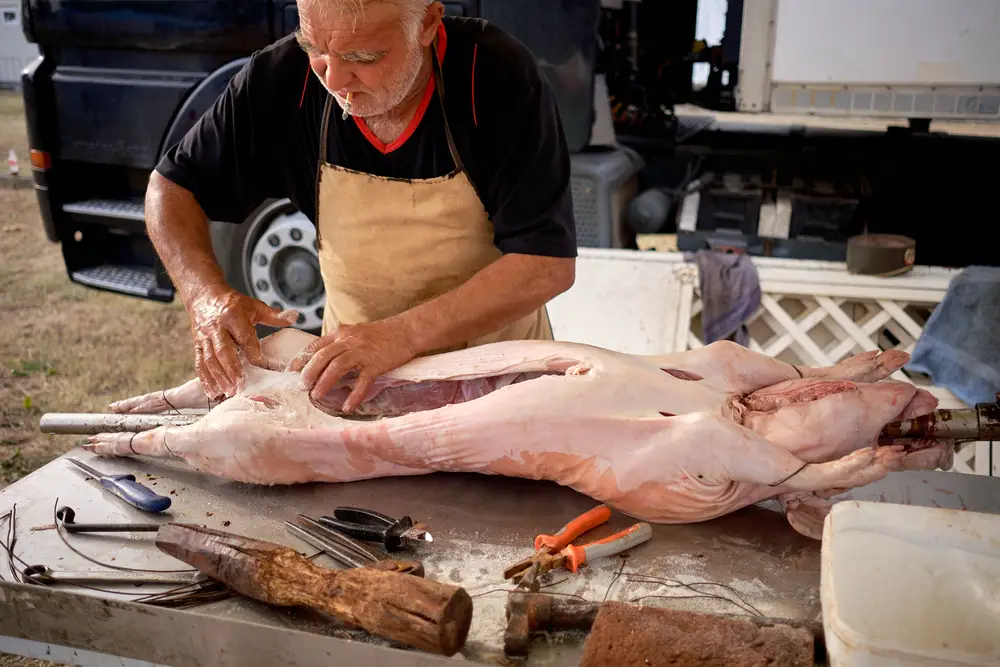Butchering a cow isn't difficult, but you may wish to get guidance from a qualified butcher during your first or second experience. Butchering any type of red meat takes patience, the right tools for the job paired with a strong focus on hygiene.
A healthy animal will quickly gain weight; consequently, any meat they produce will contain more fat, be juicier, and have a richer flavor. The meat to hide, bones, and offal ratio will also increase.
Consequently, ranchers will always maintain their meat animals in an environment that permits optimum growth and development. The optimum age for slaughtering animals depends on many factors.

Cattle that are less than 3 years old produce the best quality meat, while carves are best slaughtered in 3 to 16 weeks from birth. One can also obtain decent quality meat from older animals if they have undergone the selective fattening for their breed.
Table of Contents
1. Know Your Cattle Physiology
The carcass of an animal bred for eating comprises bones, fat, muscles, connective tissues, and membranes. The tastiest and most nutritious segments are the muscle and lean meat. It is rare to eat this muscle without consuming at least some connective tissue and attached fat.
Carcass compositions of an animal after traditional fattening methods show only a slight variation between breeds and depend mainly on how much fat the animal carries when it is slaughtered. The “lean” portions of every animal carcass comprise around 300 separate muscles. Only around 25 of these muscles are individual strands or a workable combination.
These individual muscles are very different from one another. There is a significant variation in what is known as palatability Palatability encompasses tenderness, juiciness, and flavor. It depends on how mature or old an animal is and the area of the cut.
Generally, the muscles in the hooves and legs that control locomotion are not as tender but are more flavorsome than the solely weight-bearing muscles, like the ones along the back. These support muscles are generally tenderer and less tasty.
Palatability does depend on other factors, but the age of the cow and the part of the body the meat comes from are perhaps the most crucial. Lean beef (or muscle) and fat coloring are essential for the product to be considered high quality and nutritious.
Variations from what you would consider normal pigmentation can result from an abnormal or unhealthy environment. Fat color should generally range from an extreme white to a creamy yellow.
High-Stress Levels
Animals that have suffered high-stress levels before slaughter or have had some sickness can produce fat that is pinkish or has a reddish hue. The muscle-tissue color of top-quality beef cattle should be a vivid candy-apple red.
Tissue from animals past their prime is almost always duller. You can often find dark yellow fat on some calf carcasses. This phenomenon occurs when the calf has consumed a high amount of green forage and is of a breed unable to transform yellow carotene into the colorless vitamin A.
It is also common for older ruminant carcasses to contain yellow fat.
As mentioned, a stressful slaughtering process will affect the appearance of cattle carcasses. A dark cutter, also known as DFD (or dark firm, and dry), is a beef carcass from an animal that has undergone high-stress levels prior to slaughter. This dark cutting beef is dark red and somewhat sticky, consequently making the meat appear less appetizing to consumers. Darkcutters fetch a lower price than standard beef.
Prevention of Darkcutting
Quality meat has an acidic pH level of between 5.3 and 5.7. Cows achieve this low figure by converting glycogen to lactic acid very efficiently. Substandard cattle management and feeding deplete glycogen levels and, consequently, pH levels rise as there is no lactic acid to control it.
Ante mortem stress levels reduce the amount of glycogen in muscles and the liver. The liver converts glycogen into glucose, which, post mortem, produces adenosine 5′-triphosphate or ATP anaerobically.
This ATP produces lactic acid before rigor mortis sets in. Without this lactic acid, the muscle stays above 6.0, creating more translucent and exudative muscle, i.e., muscle that retains a higher amount of water. Light can travel further into the muscle before refraction, resulting in a darker appearance.
Feeding cattle generously and keeping them calm before the cull will prevent darkcutting. The rough handling and malnourishment of livestock will lead to stress and therefore depleted levels of glycogen, which, as we have seen before, is detrimental to carcass appearance.
None of the conditions produced by stress ante mortem makes the finished product inedible. However, it makes the beef less flavorsome and lowers its visual appeal. Grocery store customers could mistake meat in this condition for something from a sick or unhealthy cow.
2. Select The Best Processing Equipment

Cutting Tools
Three knives should be enough: a seven-to-nine-inch skinning knife, an eight-inch straight boning knife, and a 12-inch curved steak knife. Avoid heavy, thick, or serrated blades when searching for the optimum skinning knife.
With more sizeable cuts, a hand-operated or electric meat saw will save you time and effort.
You may want to purchase yourself a meat grinder to make sausage or ground beef for hamburgers and mince! For domestic butchers or a small butcher shop, a one or even half-horse-power machine should have enough power to do everything you need reasonably.
It’s best to use an oil or water sharpening stone. If you choose steel, use a medium non-polished one as using polished steel sharpening stones will ruin your knife!
Surfaces
To perform a top-notch meat cutting operation, you will need a solid, non-corrosive cutting table made of stainless steel or aluminum (or a similar galvanized metal) with a rigid plastic surface. If you can only find one with a wooden top, you should use tight wooden ones or cutters.
Don’t cut on a stainless steel table or surface – you will ruin your knives quickly. Wood butcher blocks are the best to use but can be expensive. You will also need a hand wash basin and a knife sterilizer.
Storage
You should choose plastic meat trays, stackable containers, and rigid storage boxes. Metal ones are fine as long as they are made of corrosion-resistant material.
If you have meat bins, be careful not to mix the meat and always transfer it quickly to cold storage if you are not in a refrigerated room. Tote bags are a useful way of storing or moving cuts of meat. You will need special paper or foil to wrap your meat and a suitable table on which to package and temporarily leave the packs.
Consider a freezer if you are not shipping the meat immediately after processing.
Other
It is a good idea to wear a metal mask, and gloves are essential, including stainless steel mesh ones. You should also have boning and safety aprons.
A gambrel, although lightweight, can easily hold a hanging weight of hundred-pound carcasses, allowing you to work on the animal at a comfortable height. The gambrel also will spread and keep the animals’ hind legs apart, making it easier to gut, clean, and cut.
You should also consider a hoist or block and tackle to help lift the animal off the ground.
3. Carcass Butchering
The most important things to remember you butcher a beef carcass are always to cut across the grain whenever feasible, use the sharpest knives and saws, and maintain a clutter-free and well-ordered cutting table.
Remember that cleanliness, hygiene, and a germ-free environment are paramount in meat preparation.
You should prepare the forequarters and hindquarters accordingly, depending on their use, consumer wishes, and carcass quality.
Low-grade meat usually goes into processed meat products, such as sausages or meatloaf. A top-grade carcass with denser flesh will end up as steaks or roasts.
4. Find A Butcher For The First Time
If you’re still not confident to slaughter and butcher your animals yourself, it’s time to find a butcher.
Shop around and make sure you find one happy to listen to how you want things done and who will answer your questions openly and honestly. Google is your friend. Use it to get all the background information on the butcher you can.
Make Sure The Butcher Will Work How You Want
Give the butcher clear instructions about the different cuts of meat required. It would help if you gave them information, such as what cuts of meat you’d like, how thick the steaks should be, the number of steaks or chops in a pack, or whether you want ground beef.
You will be familiar with the more common cuts like a T-bone, sirloin, or ribeye, but quiz the butcher about their knowledge of other cuts like strip steak, Porterhouse, short ribs, or filet mignon.
The butcher will dispose of certain parts of the animal at the time of slaughter (brain, tongue, cheeks) unless otherwise requested. You should remember to ask to have these parts saved and ensure that nothing you need gets tossed.
You will need to explain that you want to keep items like the bones, liver, kidneys, heart, tongue, cheeks, and oxtail. Perhaps you want to keep the fat and render it for baking or frying. Rendered beef fat is called tallow.
Request that the butcher grinds the fat before giving it to you. This process will make rendering it much more manageable. Even if your butcher charges you extra to do this, it is definitely worth it.
If you are raising your own animals or buying from a local producer, it is best to start with having a trusted butcher slaughter and prepare your cattle for a few years. Eventually, you may wish to take over the processing of your meat to save money and take more control over the running of your operation.
Where Will The Slaughtering Take Place?
Will the butcher insist that you take your cattle to their place of work, or can they come to your farm? It is preferable to have the slaughtering done on your premises.
The alternative is a trip on a cattle loader, maybe through poor road conditions and uncomfortable weather conditions, not to mention the anxiety caused by loading and unloading. We have learned above that cattle must avoid undue stress to guarantee the meat produced will be as high quality as possible.

Having a butcher come to your farm may be more expensive, but it saves a ton of headaches. Transporting cattle can be a logistical nightmare, especially if the butcher is far away or difficult to reach.
